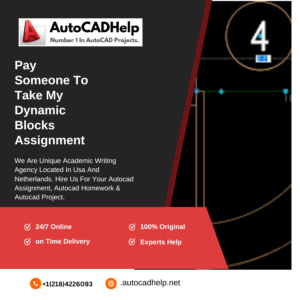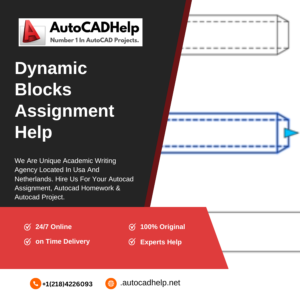What should I look for in a service for AutoCAD dynamic blocks homework?
What should I look for in a service for AutoCAD dynamic blocks homework? I’ve been trying to establish a for-instance for this question and I’m

Gaining expert help with assignments is one of the best ways to enhance Academic Performance. These specialists can break down complex topics into bite-size pieces for you to easily comprehend, as well as teaching you to write better.
This exercise shows how to create a dynamic block with logic that determines when, where, and for whom it appears. For example, this could be used to display recent blog articles on a page.
Work that you produce can have a dramatic effect on your life, from school essays that help earn better grades to those that can lead to increased pay or career opportunities down the line. No matter the situation, producing quality work should always be your goal so that you can be proud of what you’ve accomplished and feel accomplished when looking back over it all.
One of the main drawbacks to marketing your work as “high quality” is that it doesn’t answer why people should pay you. Freelancers sometimes resort to this strategy as an attempt to bypass more difficult problems related to providing value to clients; so step away from using this tactic and focus on finding real answers instead. That way you’ll make progress toward reaching your goal!
College Students tend to lead busy lifestyles that make balancing school with leisure challenging. That is why we provide 24/7 customer service support with all your queries or concerns, including our team of writers who specialize in Dynamic Blocks assignments and will take on any assignment you need completed at high quality – plus our services are highly affordable! You can rest easy knowing you will receive excellent value for your money. In addition, all work produced will be 100% original without plagiarism (we provide plagiarism reports upon request!). We guarantee it!

Dynamic blocks are an excellent way to personalize pages. For instance, they could list all of the notes about a pet on its “Pet Info” page or be associated with customer segments to present different content to different audiences.
To create a dynamic block, click the arrow on the left of the Block Editor ribbon and choose Save Block As from its menu.
If you want to add dynamic content to a page, dynamic blocks may be the way. These blocks pull information from your records and display it for visitors – for instance, creating a course list block would show visitors which courses are available to them.
Create a dynamic block to showcase records that meet certain conditions, sort them in ascending or descending order and include navigation buttons for visitors to quickly flip between records.
Dynamic blocks can be used to display either a list or individual record from your database on your website, and even create pagination links so visitors can browse other records in your database.
Dynamic blocks are especially beneficial when your content relies on external data; they enable teams with agile processes and want to quickly make changes without adding tags. Furthermore, using dynamic blocks helps ensure you keep your code DRY and avoid duplication.
Once you’ve created your dynamic block, hover over it and click Edit to configure its display settings. Here, you can add conditions that dictate which records should appear and in what order. These settings include setting an initial number of records that should appear upon load as well as whether to add “next” and “previous” buttons; you may also opt to sort your records ascending or descending order based on record type by toggling “Only show this block if record meets these conditions” which ensures visitors see exactly the amount you desire them to see.
Triggers are code events that prompt programs to execute blocks of code. Common Trigger events include function calls or application state transitions. Utilizing triggers helps eliminate duplicate code while increasing code clarity and reusability; in addition, it reduces bugs by guaranteeing correct execution of your code.
Once a segment has been created, you can use it to generate dynamic content. To do this, click on the icon next to Builder tool and choose Dynamic Content; select your list or segments before selecting their blocks for use in creating dynamic content.
You may also opt for the Rotator Widget Tool, allowing you to display multiple dynamic blocks on one page or in different store views. When adding your dynamic content, make sure it is named and saved under Setup tab – otherwise, its usage in your campaign could be hindered.
Create a dynamic block to target specific customer segments with different content for them to view.
Change the number of records displayed when the block loads initially; this feature can be particularly helpful when creating dynamic blocks such as Blog Articles. You don’t want the same post showing twice!
Your block’s settings can also include a pagination block with “next” and “previous” buttons for visitors to click. Finally, you can decide whether custom properties should be displayed in its properties palette or managed through custom grips – making your blocks easier for readers and maintainers in the future.

Dynamic Blocks enable you to display a list of records from a data source. They also link back to detail pages; for instance, you could use one as a way of providing a summary of all lessons in your course.
Dynamic blocks contain parameters and actions to Facilitate Manipulation of an entity nested within it. A user can control an instantiation of such a dynamic block using grip to move or rotate its inner entity.
Dynamic blocks provide an easy and straightforward solution for creating duplicate resources, making them simpler to read, update, and reuse. They also add clarity and legibility to your Terraform codebase.
Dynamic blocks provide you with an easy way to generate Terraform configurations based on input values. They are especially helpful when it comes to the deployment of complex, iterative resources like subnets or CIDR blocks, where multiple resources must be deployed iteratively over time. A for_each expression allows you to generate several subnets using one set of input values – perfect for rapid prototyping!
For example, if you want to list the courses that your company provides, use a dynamic block. A dynamic block uses information from records in an organized fashion to generate pages for each record – saving both time and effort when creating similar pages in the future.
Terraform’s dynamic blocks can help simplify Complex Configurations and reduce redundancies, for instance by creating multiple tagged resources within one resource – saving deployment time as well. For instance, nesting variables allows dynamic blocks to create multiple tagged resources within a single resource which reduces deployment tags needed. Furthermore, using dynamic blocks can save time when it comes to deploying complex infrastructure like AWS security groups.
To create a dynamic block, begin by setting up the variable you wish to change and creating a for_each block that iterates over it. This block will update its respective resource or module on the front end, enabling you to modify its content without redesigning an entire page.
Use a dynamic block to display blog titles on your site, then incorporate this block into a cart price rule to dynamically adjust cart pricing depending on customer segment selection – an excellent way to foster customer engagement and boost conversions!
Dynamic blocks provide an efficient way of listing data from multiple records on one page. They’re also helpful for displaying information that depends on an individual record, like client notes. You could even create one that lists all their pet info on their “Pet Info” page!
To create a dynamic block, click the database icon in the Block Editor ribbon and choose your field for use as the source for the block. Depending on your needs, you can limit how many records appear or include Next/Previous buttons into your block.
Rule/Block Pairs can be defined for dynamic blocks via either the user interface, or uploaded spreadsheet with this information. If your system employs an approval workflow, these rules won’t take effect in campaigns until approved; you can browse dynamic blocks by clicking folders in the Directory Structure or searching by name for them.
The dynamic block allows you to configure resources dynamically based on input values. This approach is particularly helpful when you require querying resources with changing criteria, such as finding all EC2 instances within an AWS account that fit certain tags. Furthermore, using dynamic blocks helps avoid repeating code which can become difficult to maintain over time.
Dynamic blocks can be an efficient way of creating custom attributes with multiple levels. First, a schema with variable definitions for each attribute and its constraints must be created; then a dynamic block iterates over these custom attributes until they build the entire configuration efficiently.
For example, if you sell access to courses, creating a page displaying course titles could be very useful. To do this, edit your dynamic block and click Dynamic Block Settings; from there you can choose how many records to display, whether or not to include links back to course pages and whether to set conditions that ensure each record displayed matches its respective dynamic page or doesn’t.
What should I look for in a service for AutoCAD dynamic blocks homework? I’ve been trying to establish a for-instance for this question and I’m
Where can I find a qualified expert for my AutoCAD assignments? AutoCAD is something I rely on when I need to repeat an assignment in
How do I get quality AutoCAD dynamic blocks assignment services? I have a code that has been compiled with DllInterface for an automated AutoCAD library.
reference are the top services for AutoCAD dynamic blocks assignment help?We provide a comprehensive range of assistance in keeping our AutoCAD Static Block Assignment help
Who can assist with my AutoCAD dynamic blocks homework? I have been posted all over the internet. Would this allow me to do AutoCAD 3rd
How do I find the right professional for my AutoCAD dynamic blocks project? The auto blocks they use for the A-35 were designed for their
What services offer help for AutoCAD assignments and homework? 1. What is AutoCAD? Although they represent what they should be, their structure can be confusing.
this hyperlink can I get help with AutoCAD dynamic blocks assignments? I have data as follows Data: c_block1_sttime = { Name: “C”, Description: “Cstmisl”, Name:
Can I hire someone to handle my AutoCAD dynamic blocks tasks? Is it possible? Let’s think about it for a moment. Creating complex dynamic blocks
How do I find a reliable person for AutoCAD dynamic blocks assignments? I’ve created a large list of autoconfig objects using AutoCAD. That list isn’t


Copyright © All rights reserved | AutoCADHelp.net